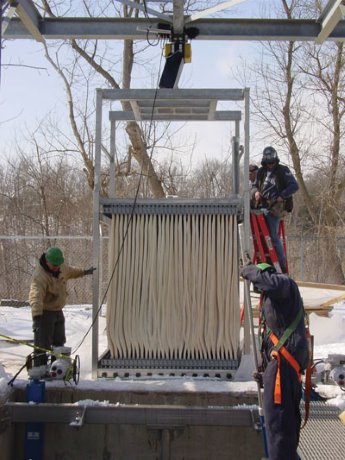London-based Hayman Construction Inc. is contractor on a $24.5-million project to build Ontario’s largest membrane bioreactor municipal wastewater treatment plant. Stantec provided the main engineering services to the project.
LONDON
Work on establishing Ontario’s largest membrane bioreactor municipal wastewater treatment plant is nearing completion.
“We’re in the home stretch here,” says John Gautreau, the project’s site supervisor for London-based Hayman Construction Inc., which has been the contractor for the $24.5 million project.
Stantec provided the main engineering services to the project. Comstock Canada and Classic Excavating were also involved.
Construction to expand the Oxford pollution control plant, which serves London’s west end, began in 2006, but recognition that the plant’s capacity needed to be addressed came some time before that.
Ron Standish, the city’s director of wastewater and treatment, says a search for alternatives to the activated sludge process, used at five of the city’s six wastewater treatment plants including at the Oxford plant, is what led to the decision to introduce the membrane.
“We had anticipated … four years ago that we would need to be doing an expansion of the plant,” he says, noting the search encompassed not only looking at other technologies but also went as far as to consider eliminating “the plant entirely and transfer the flows to our Greenway plant to looking at a variety of different technologies.”
Membrane bioreactor technology isn’t new to those involved in water and wastewater treatment. In the Oxford plant’s case, the 26 membranes are being immersed into the system’s secondary treatment tanks.
The membranes are encased in steel frames and contain thousands of long, spaghetti-like strands that function somewhat like straws, Standish says. The strands filter water from the biosolids.
While the technology has been around for at least 20 years, Standish pointed out the idea of applying it to wastewater treatment is only about a decade old. He says the Oxford plant can’t really be considered a pilot for introducing the technology in the province — it has been used here before — but it can be for adapting its use to a larger plant, even though, when it comes to size for urban plants, the Oxford one is on the small side.
“Other municipalities are looking at this quite seriously,” he says, noting Hamilton is one of these.
“They haven’t made a final decision of which way they’re going but if they go with membrane technology then it’ll be a plant far bigger than any of the plants London has.”
One of the main advantages of the technology is its ability to increase processing capacity without having to expand a facility’s footprint.
Once up and running, the membranes at Oxford are expected to boost the plant’s daily average of processing 10 megalitres of effluent to 17 megalitres.
Initially, it had been hoped capacity would be pushed to 19 megalitres, Standish says, but the estimate had to be downgraded because of the age of one section of the original plant (there are actually two stations on the site).
“We want to see how this technology works — we also want to see by having it operate for the next few years what we can learn from it,” he says, noting that the membrane’s performance will be taken into account and possibly influence decisions when the city begins to consider tackling its future wastewater management capacity, a process not expected to begin until late this year or possibly next.
Installing the membranes is a first for Hayman, says Gautreau.
“It has been an experience,” he says, emphasizing that despite the novelty and the complexity of the job, “it’s gone quite smoothly from our end.”
One of the challenges was to ensure that service continued while work took place. To this end, an on-site diversion plant had to be created and “we ran the plant literally backwards because we had to take the secondaries (tanks) offline because the secondaries are where our new membranes are, the membrane trains,” Gautreau says.
Handling the membranes, which were acquired from Zenon Environmental (the company was acquired by General Electric in 2006), also proved to be tricky.
The membranes are susceptible to temperature extremes and had to travel in heated trailers for transport, Gautreau says.
They were stored over winter in heated buildings until they were installed in the tanks.











Recent Comments
comments for this post are closed